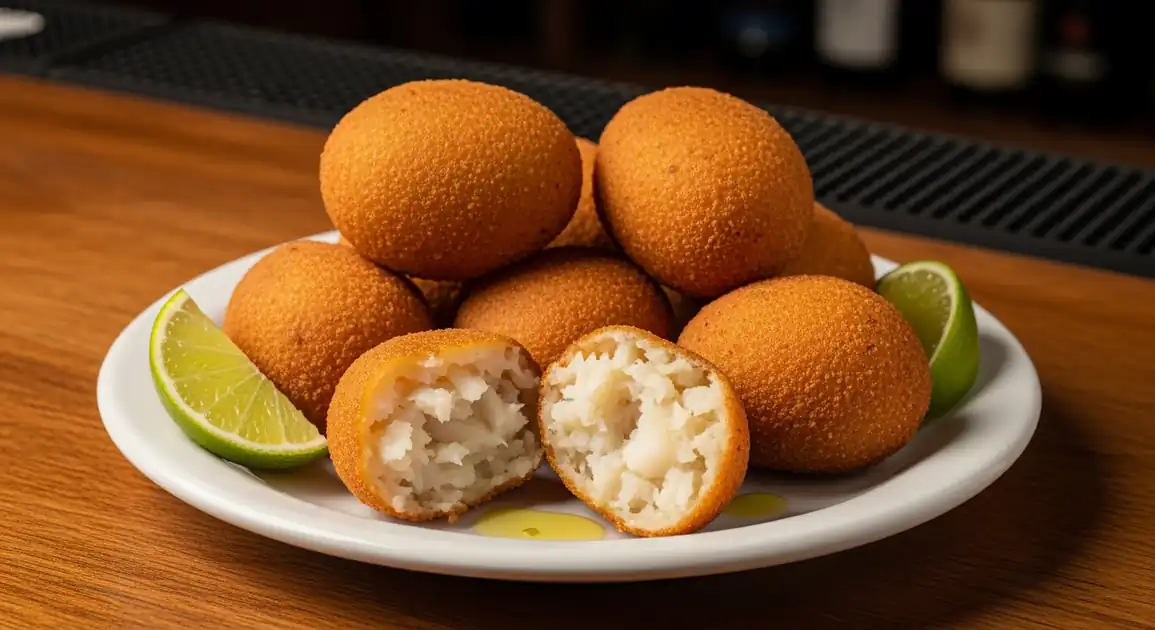Bolinho de Bacalhau (Salt Cod Fritter)
Bolinho de Bacalhau

Description
Bolinho de Bacalhau is a nationwide favorite in Brazil, found from casual 'botecos' to upscale restaurants. Its popularity transcends regions, deeply rooted in the country's Portuguese heritage. Quality and recipe nuances can vary, but it's a reliable and beloved 'petisco' everywhere.
Dietary Information
Serving information
Serving style
Served hot in portions ('porção') or individually ('unidade'). Always accompanied by lime wedges. Olive oil ('azeite') and chili oil/sauce ('pimenta') are commonly offered or available on the table.
Quick facts
Botecos: Often late morning until late night (e.g., 11 AM - 12 AM or later). Restaurants: Lunch (12 PM - 3 PM), Dinner (6 PM - 11 PM).
Safety Tips
What to Look For
-
Fried fresh to order ('Frito na Hora')
Ensures the bolinho is piping hot, crispy, and hasn't been sitting at unsafe temperatures. This minimizes risks and maximizes taste.
-
Served piping hot
Heat is a key safety factor in fried foods. The inside should be steaming.
-
Clean frying station and vendor hygiene
Look for clean oil, utensils, and proper food handling practices by the staff.
-
Crispy, golden-brown exterior
Indicates proper frying temperature and technique. Avoid soggy or burnt bolinhos.
-
Reputable bar or restaurant ('Boteco de Confiança')
Established places with good local reputation are generally safer bets for quality and hygiene.
What to avoid
-
Pre-fried bolinhos sitting under heat lamps or at room temperature
These can harbor bacteria and will lose their optimal texture. Insist on freshly fried.
-
Bolinhos that are lukewarm or cold
Indicates improper holding temperature, a significant food safety risk.
-
Excessively dark or dirty frying oil
Old oil can impart bad flavors and potentially contain harmful compounds.
-
Soggy or overly greasy appearance
May indicate oil temperature was too low (absorbing excess oil) or the bolinho is old.
-
Strong 'off' fishy smell
While cod has a distinct smell, a pungent, unpleasant fishy odor could indicate the bacalhau wasn't fresh or properly prepared.
Price information
Price range
Budget tips
- Prices are usually per unit ('unidade') or per portion ('porção', typically 4-8 units).
- Casual 'botecos' offer the best prices (5-8 BRL/unit, 25-40 BRL/porção).
- Restaurants, especially in tourist areas, will charge more (8-15 BRL/unit, 40-70 BRL/porção).
- Portions are often better value for sharing.
Value indicators
- Good size and plumpness.
- Generous ratio of cod to potato (ask locals for recommendations!).
- Crispy exterior, creamy interior.
- Fried fresh to order.
- Served with fresh lime.
Where to Find This Dish
Botecos (Local Bars)
Ubiquitous nationwide. Look for traditional bars with simple setups, often with sidewalk seating.
Neighborhood bars, Bars near markets or plazas
5 PM - 11 PM
Portuguese Restaurants
Restaurants specializing in Portuguese cuisine almost always feature high-quality Bolinhos de Bacalhau.
Dedicated Portuguese restaurants
Lunch, Dinner
Traditional Brazilian Restaurants
Many restaurants serving regional or general Brazilian cuisine include it on their appetizer menu.
Mid-range to upscale restaurants
Lunch, Dinner
Vendor Tips
- Ask locals for their favorite 'boteco' for bolinhos.
- Confirm if they are 'feitos na casa' (homemade) or commercial.
- Request 'bem quentinho' (nice and hot).
How to Order
Regional Variations
-
Classic Bolinho Shape
(Formato Quenelle/Oval)
The traditional shape, often formed using two spoons, resulting in a small oval or quenelle.
-
Round Bolinho
(Formato Redondo/Bolinha)
Sometimes shaped into small balls instead of ovals.
-
Bolão de Bacalhau
(Bolão de Bacalhau)
A much larger version ('bolão' means big ball) of the classic fritter, sometimes with a slightly different ratio or added ingredients like cheese inside.
-
Seasoning Variations
(Variações de Tempero)
Minor variations in the amount of garlic, onion, parsley, or addition of black pepper.
Cultural context
History
Salt cod ('bacalhau') is deeply ingrained in Portuguese cuisine due to historical maritime exploration and preservation methods. This culinary tradition was brought to Brazil during colonization. Bolinho de Bacalhau emerged as a popular way to utilize this prized ingredient, adapting Portuguese recipes to the Brazilian palate. It has since become a ubiquitous and cherished part of Brazil's gastronomic culture, especially within the social context of 'botecos'.
Local significance
A quintessential Brazilian 'petisco', embodying the culture of socializing in bars ('botecos') with friends over snacks and cold beer. Represents the strong Portuguese culinary influence.
Eating customs
- Sharing a portion ('porção') is common.
- Using fingers to eat is acceptable in casual settings.
- Mandatory squeeze of lime is typical.
- Paired most often with very cold beer.